In the Amazon, Religious Women Lead the Way
A Brazilian Catholic nun advocates for women and the environment -- and risks her life to protect the planet
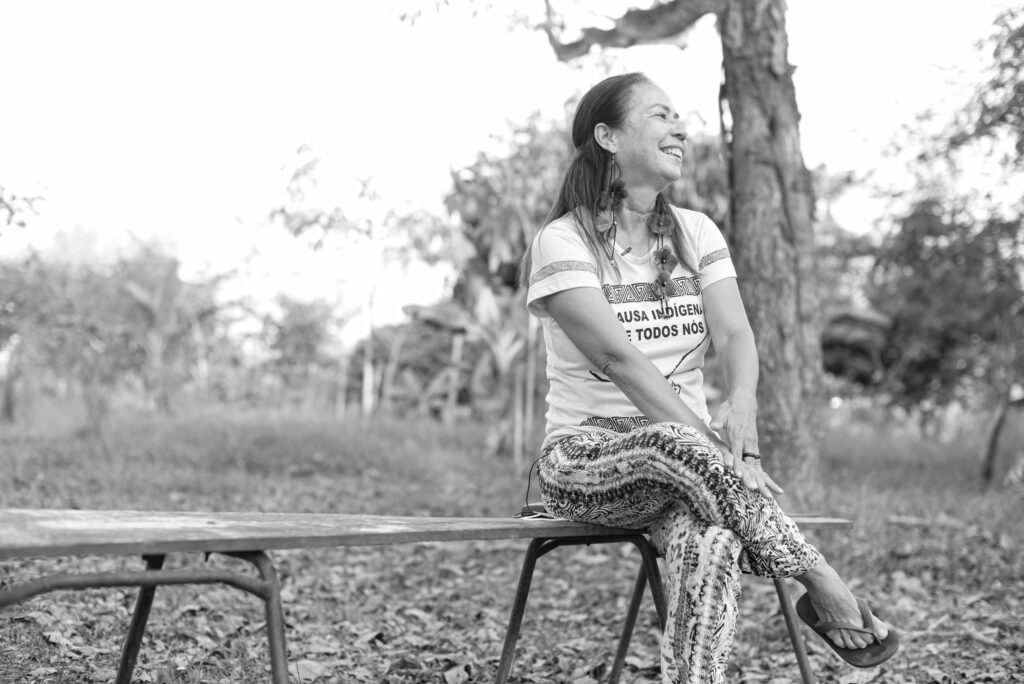
(Sister Laura Manso Pereira in Porto Velho, Brazil, 2022. By Gabriel Bicho.)
A hazy pink dawn rises on a statue of Nossa Senhora da Conceição Aparecida, “Our Lady of the Immaculate Conception who Appeared.” Her onyx face is almost visible in the sunrise, but not quite. The starkly painted white of her eyes pierces the shadows.
The story of the appearance is that a statuette of Mary was found floating offshore when a group of fishermen had prayed for a catch in a dry season. They suddenly found their nets full of fish, and the dark-skinned statue alongside them. She is now known as the patrona of all Brazil, and of the Earth’s rivers and seas.
The painted statuette of Our Lady of Aparecida is about 3 feet tall and wears a dress embroidered with golden thread. A Black Madonna, standing in prayer upon clouds and angels.
On a nearby lot, a groundskeeper reaches up to a tree branch, pulling down a pod that she cracks open and nibbles from her fingers: “tamarindo.” Soon it will be hot; an unceasing, still heat through the end of the day.
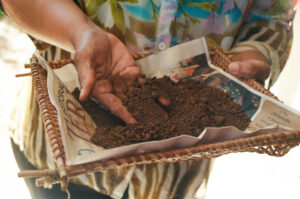
(Earth offering. Photo by Pilar Timpane)
On this compound that belongs to the Catholic Archdiocese of Porto Velho, Brazil, a mass is beginning. Led by guitar, drums, singing, and local Amazonian instruments, women dressed in a mixture of indigenous feather headpieces and street clothes are entering with an offering of elements: sifted sienna-brown earth in a woven wicker pan, a candle whose flame bounces in the morning light, a rainbow flag that beats air into wind, and a bowl filled with water. The natural elements are presented in the mass before the liturgy is read or Communion is shared. The women carry the soil and other elements to the congregants to touch in reverence. Following the crowd, I pick up some of the dirt and it runs over my hand like a baptism of earth.
On the floor, the congregation is laying an altar of sacred objects. Each has a connection to the Amazonian locals – especially indigenous people and workers – and the abundant local flora and fauna: banana leaves, flower stems, corn, candles, an orange tree branch, a machete for the farmer, a metal sickle for the worker, and religious images of Jesus and Mary. Throughout the mass, the services are performed in this distinct Amazonian style, with songs from indigenous leaders in their native dialects, in synergy with the Catholic liturgy.
In the midst of the congregation is a confident, small-framed Brazilian woman. Dressed in the unassuming plainclothes of a t-shirt and shorts, it is not obvious that this woman is a nun. Sister Laura Vicuña Pereira Manso is wearing the feather arrangements of the local indigenous artisans in her hair. Her smile is bright and infectious, and her cheerful voice and passion animate the congregation.
In the hot days of July 2022, Sister Pereira Manso is leading a consultation to collect feedback and increase dialogue as a part of the Catholic church’s “Synod on Synodality.” Listening sessions such as this took place globally, and the church-wide Synod process will lead to a meeting of Bishops and possible reforms under Pope Francis.
Sister Pereira Manso is spunky and light on her feet, and floats around the archdiocese grounds like a butterfly to flowers; each person and group who has arrived to take part in the sessions greets her. She knows them all by name. She has invited me to document her work around the Synod, in the context of a longform documentary I am directing about women in the global Catholic church.
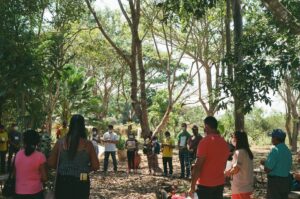
(Synodal gathering in Porto Velho, Brazil, 2022. By Pilar Timpane)
Here on the outskirts of the Amazon region of Rondônia, Brazil, Sister Pereira Manso and her colleagues from the archdiocese have brought together a diverse group of regional leaders. The local Archbishop Roque Paloschi is also present. He supports Sister Pereira Manso and has worked with her to promote this event. Attendees include representatives such as the first female chief of the indigenous Purubora people, river workers, members of the LGBT community, women’s groups, Catholic missionaries, and farmworkers. These groups with distinct goals share a common, resounding commitment to have their community interests heard and supported through a mass movement for land protection. And they want the Catholic church to support them through public denunciation of the environmental degradation and cultural genocide that is happening, and to publicly support their needs.
Sister Pereira Manso has a nearly 25-year history of working closely with indigenous peoples, made clear in this diverse community’s trust of her and participation in this event. For many years, Sister Pereira Manso has denounced Bolsonaro-era policies that promoted development and an open-door policy to agrobusiness. These policies resulted in large-scale logging and threatened major deforestation and loss of indigenous peoples’ homelands. As the Amazonian ecosystem is destroyed, so are their homes and well-being. Without clear demarcation, the borders of their sacred lands continue to be pushed back and edged up on little by little, slowly displacing people and causing violent conflict. Illegal forest arsons on indigenous territories that inhabitants believe were set by loggers have scattered communities. In 2019, these fires were noted by National Geographic to have been so large they were visible from space.
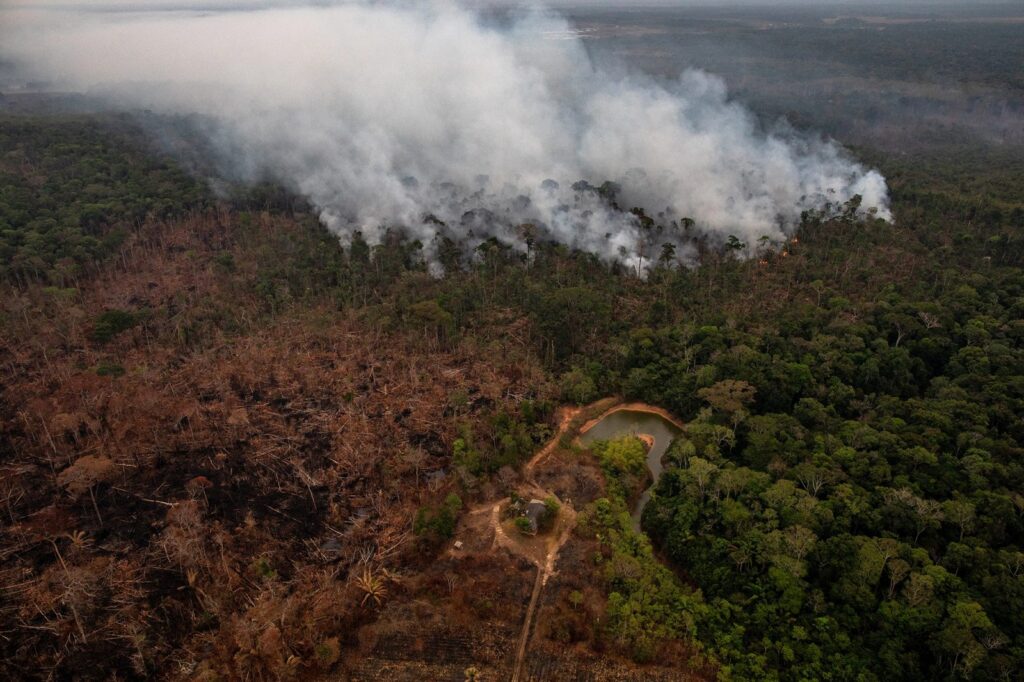
(Burning fire in Rondonia. Source: Victor Moriyama for the New York Times)
By advocating for those whose lives have been endangered by these land-grabbing and life-threatening practices, Sister Pereira Manso has herself been in danger. She often goes directly to the sites where companies set intentional fires to intimidate villagers to move. Along with others, they record video of the fires to show at press conferences, and to share among social media groups.
As a nun, Sister Pereira Manso also works closely with the Brazilian Catholic church in close unity with Bishops and her fellow ministers in the region. She says that fewer and fewer priests are available for worship services in their region, and at times a priest will only be available every 6 months to a year. So, the work of nuns and lay women ministers (those who have not taken religious vows) often keep communities going through tasks as varied as baptisms and marriage ceremonies. At the same time, women are active in public health, education, and protecting the land for future generations.
For Sister Pereira Manso, legitimizing the work and place of women in the church is crucial to the health and life of Catholicism, as well as the safety and preservation of the planet.
Recently, Sister Pereira Manso’s work caught the Vatican’s attention. She was invited to speak at the Pan-Amazon Synod in 2019 about the issues facing the Amazonian region and women’s leadership in the area. The event brought Amazonian leaders from many countries to address Pope Francis and call global attention to the environmental, social, and spiritual needs of their communities. After years of his vocal support for indigenous groups around the world, the Pan-Amazon Synod was one of Pope Francis’ major events to catalyze listening and support for these regions that face human rights violations, cultural erasure, and environmental devastation.
As an auditor at the Pan-Amazon Synod, Sister Pereira Manso brought her message about the importance of environmental protection and of including greater roles for women in leadership positions in the church.
“Women are the guardian of life itself. It is the woman who does all these processes of defense of life, of territories, and of rights. We have this great mission of defending life itself; Pope Francis himself calls us all to work for an integral ecology,” she said. “I think that the Amazon is a region that is strategic for the world and essential for the world. And women have been carrying out these processes of defending life, land, and rights.”
Given the central place women play in the Amazonian church and in the defense of the environment, Sister Pereira Manso always makes it a point to express the clear connection between women’s leadership and ecological protection. For her, the promotion of women to places of decision-making in the Catholic church is one way to give women a more equal standing in society. If Catholic women were elevated to places of decision – that of deacon, for example – it could have an impact on the ecological safety of these communities since women are among the most ardent defenders of the land, and they make up a sizeable portion of the agricultural and cultural producers. Sister Pereira Manso’s position is backed by groups like the United Nations, who agree that women need to be front and center when addressing climate and environmental challenges.
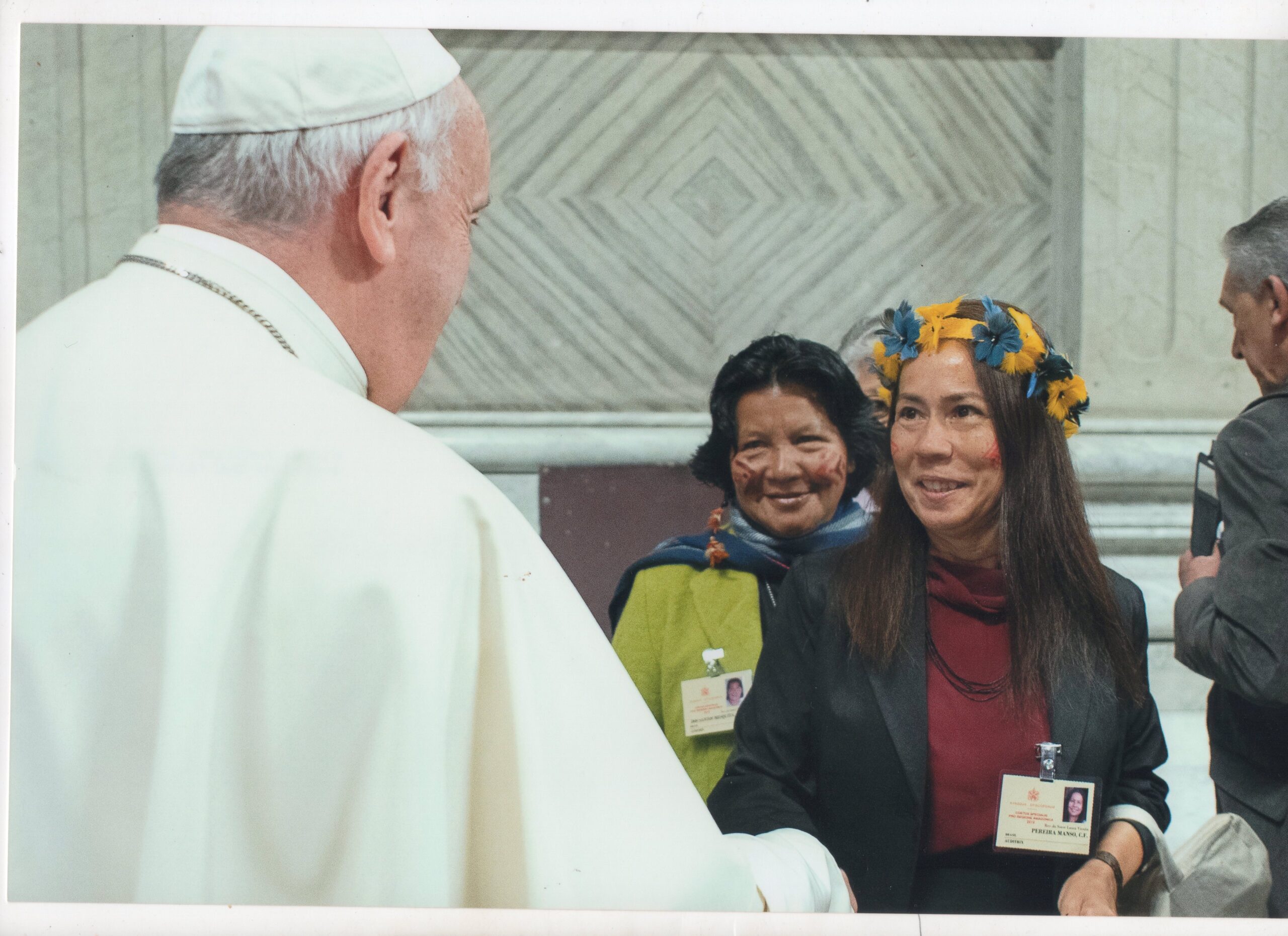
(Photo courtesy of Sister Laura Pereira Manso)
Women requesting greater leadership roles and ordination in the Catholic church is not new, but recent reforms and promotions of women within the Vatican have made it seem that a door could open to changes. Leaders such as Sister Pereira Manso are showing that many women already do much of the church’s work today. And indeed, Sister Pereira Manso has been called to present on this very topic at the Vatican several times; she, herself, was promoted to a high leadership position in a newly created decision-making body in the South American church.
But, so far, the Vatican has given no indication that it will give women elevated leadership roles or ordination.
“We still have a lot of difficulty in full leadership. Androcentrism, patriarchy and clericalism are still very strongly present in our churches,” says Sister Pereira Manso on why women’s leadership is being held back.
Sister Pereira Manso works with many women organizers and leaders because they are essential to the health of their communities and the protection of their environment. One such organizer is Chief Hozana of the Purubora people who also attended the Pan-Amazonian Synod in 2019 in Rome. For twenty years, she has been the leader of her community and is the first female chief, she says, in Rondônia. She told me that bringing this message to the Vatican left a mark on her, and that she wishes the church could make a hundred religious leaders just like Sister Pereira Manso.
“It was a very important meeting for us,” Hozana says of the Amazonian Synod. “For indigenous women to have a voice. To cry out. Other heads of states have not privileged our voice. In that space, Pope Francis asked for the indigenous leaders to be brought together with the other heads of state.”
***
Back at Sister Pereira Manso’s religious community compound in Porto Velho, she and her Franciscan sisters have a small chapel where they gather for daily prayer and a garden where they grow organic vegetables. The walls are adorned with casique, indigenous headdresses, forest objects like a hummingbird’s nest, and religious symbols like Our Lady of Aparecida. Sister Pereira Manso takes it for granted that these symbols of spiritual power are at home with one another, a mélange of indigenous and Catholic objects. For her, it’s essential to guard the spiritual traditions of the Amazon, incorporate them into Catholicism, and not allow Western European ideas of Christianity to dominate.
“I think that the church is an ally of great potential for the people, for the leaders in this community who are a part of this work,” says Sister Pereira Manso. “The church that I was born in, that I have learned from my mother, is this church that is with their people, that is in the midst of the people, who walk together with the people,” she says. “It’s this presence of the church that is next to them without doing many things. Just being a presence.”
Sister Pereira Manso was raised in a Catholic family in Porto Velho, and her family’s roots are to the Kariri Brazilian tribal group. She says she remembers sleeping in hammocks every night growing up, and playing by the wide brown Madeira River, their local tributary of the Amazon. The river and surrounding Amazonian territories of Rondônia are home to at least 21 indigenous communities and are some of the most biodiverse regions on the planet.
Because of her outspoken advocacy, Sister Pereira Manso has exposed herself to dangerous threats from groups who see her work as a burden to land expansion and illegal deforestation.
“When people begin to make themselves the protagonist of their own stories and assume their own struggles, they begin to make structural changes,” she says. “That bothers the powerful very much. So, we know if the powerful are angry, they begin to persecute us.”
Although she is confident anywhere, even debating Cardinals in the halls of the Vatican, Sister Pereira Manso is clearly the most comfortable and vibrant when she is at home in Brazil and among the original peoples of this land. Much of her work in the Amazon over more than two decades is among the Karipuna people. The Karipuna are, she says, an extremely endangered indigenous group in Rondônia whose numbers have dwindled so far down that they are on the brink of demise. Because of deforestation, land-grabbing, and threats on their lives, the Karipuna leaders have had to bring their case before state and national governments, trying to expose the agrobusiness companies and Bolsonaro-era policies that have opened the door to a slow genocide of tribal groups like theirs around the Amazon.
The Karipuna’s story is, unfortunately, not unique. There are many tribal groups who are losing population and land to these developments. In the summer of 2022, the Armed Conflict Location & Event Data Project noted a 140% increase in violence between state forces and armed groups in Rondônia — many of which are illegal logging or mining enterprises.
Sister Manso Pereira knows that her connection to the church and her work as a leader offers some protection to her friends, the Karipuna people.
“The Karipuna once said to me, ‘We sleep well when you are here, because you’re with us.’ I said, ‘Why? If they come for you to kill you, they’re going to kill me, too.’ And they said, ‘We know if you went missing, the church would come looking for you. They would know you were gone.’”
Sister Manso Pereira’s eyes mist with tears when she says this, but also a wry smile spreads across her lips; as if out of one side of her mouth come these dangerous anecdotes and out of the other complete peace with the possible consequences of this advocacy.
On one night with the Karipuna, she tells me, they were sure that an assailant was close by in the forest. Out of fear, they moved quietly and without lanterns, walking for miles in the dark. She believes that Our Lady of Aparecida protected them.
“By forest, by river, I always believe that she is with me. That she protects me. Because of that, I am not afraid. [That night in the forest] I didn’t sleep because every leaf that made a sound could be someone coming with a gun to kill us. But I thought, yes, Our Lady of Aparecida, she is our mother, and she has protected us well.”
Pilar Timpane is a documentary filmmaker based in Durham and New York City. Sister Laura Vicuña Pereira Manso’s work and the changing role of women in the global Catholic Church are the subject of her feature length film in progress.